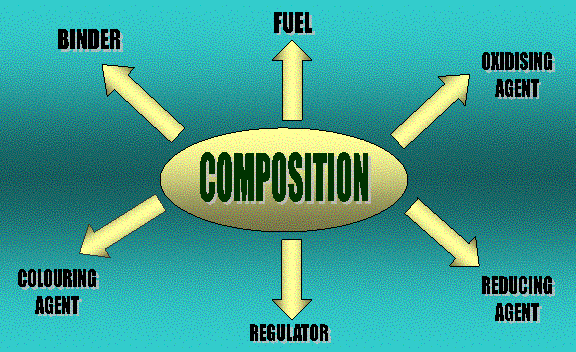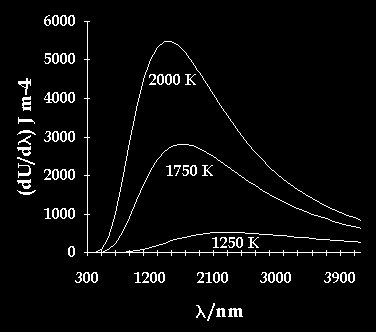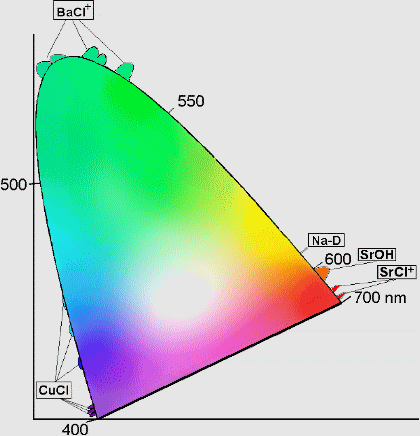Composition
The Chemistry of fireworks is based on the simple theory of combustion. The composition inside the firework must however contain 6 vital ingredients:

Fuel
Charcoal, commonly known in the pyrotechnic industry as black powder is the most common fuel used in fireworks. Normally, all fuels will contain an organic element such as charcoal or thermite.
The mechanism by which the fuel functions in the firework is relatively simple. The fuel loses electrons to atoms within the oxidiser (thereby reducing the oxidiser) and releasing atoms from the oxidiser. During this process, bonds are formed between the fuel and oxygen atoms forming a product which is relatively stable. However, only a minimal amount of energy is required to start the combustion of this fuel-oxidiser compound. When combustion does start, the result is a massive release of energy as the solid mixture liquefies and vaporises into the flame of ignition. This maximises the probability of reaction of the oxidiser as it is brought into the close proximity of the flame.
Oxidising Agents
The function of the oxidising agent is to produce the oxygen needed in order for the mixture inside the firework to burn. These oxidisers can be nitrates, chlorates or perchlorates.
Nitrates only give up a third of their oxygen as the equation above illustrates.
On the contrary, Chlorates get completely reduced as they are better oxidising agents and so cause an even more spectacular reaction. This however does cause the reaction to become extremely explosive.
Perchlorates contain even more oxygen but are less likely to explode than chlorates due to their increase in stability. They follow the reaction below:
Reducing Agents
The second part to a firework is the reducing agent. These burn the oxygen provided by the oxidising agents to produce hot gasses.
Common reducing agents are Sulphur and Charcoal. These react with the oxygen to form Sulphur dioxide and Carbon dioxide respectively as illustrated below.

By mixing both the reducing agents, the speed of the reaction can be controlled.
Regulators
Metals can be added to regulate the speed at which the reaction. The larger the surface area of the metal, the faster the reaction will proceed (collision theory).
Colouring Agents
Different chemicals are used to produce different coloured fireworks. Therefore, in order to produce a firework of a certain colour, the correct corresponding chemical or as the case may be, mixture of chemicals can be used:
| Metal | Colour |
|---|---|
| Strontium | Red |
| Copper | Blue |
| Barium | Green |
| Sodium | Yellow/Orange |
| Calcium | Orange |
| Gold | Iron |
Hence Strontium used in conjunction with Copper will yield a purple firework.
The incandescence from the elements occurs when solid particles are heated in the flame to extremely high temperatures. These release excess energy in the form of light (hv) at the broad end of the spectrum. The higher the temperature, the shorter the wavelength at which light is emitted, and the nearer it tends toward the blue end of the coloured spectrum. This is why blue coloured fireworks are so hard to synthesise, as they only occur at very high temperatures.
Binders
Binders are used to hold what is essentially the mixture of the firework together in a paste like mixture. The most commonly used binder is known as dextrin, a type of starch which holds the composition together. Paron can also be used in binding, however it is less common and only used in conjunction with red and green fireworks as it helps to enhance their colour. The binders do not actually begin to work until the firework has been lit as they are too unstable for storage wit
hin the firework and are hence potentially dangerous.
Light and Colour
Fireworks have lit up the night sky for centuries however, colour is an invention that has only been introduced into displays in the last 100 years.
Before the 19th Century, the only colours that could be produced were yellows and oranges with the use of steel and charcoal. Later development involved Chlorates which introduced basic reds and greens to the repertoire. Good blues and purples were not developed until this century and the quest for the formation of a deep forest green coloured firework continues still to this day.
Colour production in fireworks involves two main mechanisms:
1) Incandesence
2) Luminescence
2) Luminescence
Incandescence is the light produced from heat. Heat causes a substance to grow hot and glow. This results in the emission of infrared, then red, orange, yellow, and white light as the substance grows increasingly hotter. The power of this emission can be defined as:
M = sT4
Where s is the Stefan-Boltzmann constant and T is the temperature.
It is apparent from the equation that a twofold increase in emission can be caused by increasing the flame temperature from 400K to 800K.
The calculated emission spectrum has the following shape:

The graph illustrates that different temperatures produces a different wavenumber with a different power of emission and so produce a different colour of light.
The following table gives a summary of the temperatures at which various colours will occur.
| Temperature (K) | Temperature (0C) | Subjective Colour |
|---|---|---|
| 750 | 480 | Faint red glow |
| 850 | 580 | Dark red |
| 1000 | 730 | Bright red/orange |
| 1200 | 930 | Bright orange |
| 1400 | 1100 | Pale orange/yellow |
| 1600 | 1300 | Yellow/white |
| >1700 | >1400 | White |
Blues and greens require much higher temperatures (ones which are impractical for fireworks) and so cannot be formed using this method.
Instead, they are created via the mechanism of Luminescence.
Luminescence is light produced using energy sources other than heat. This involves the absorption of energy by an electron of an atom or molecule thereby causing it to become excited but also unstable. As the electron drops back down to its ground state, energy is released and in this case, it is in the form of light as the energy is released in the form of a phonon. The energy of the phonon determines its wavelength and colour.
Certain molecules emit light in the visible region and these are used to produce the colours seen in fireworks. Some of these however need to be combined with another element to stabi lise them and make them fit for use within fireworks. For example, Barium must be combined with chlorinated rubber as it is unstable at room temperature. On the contrary, Copper Chloride is instable at high temperatures and it must be ensured that the firework does not get too hot.
The following table illustrates the compounds required to produce specific coloured fireworks.
| Colour | Compound | Wavelength of Light |
|---|---|---|
| Red | Strontium Salts & Lithium Salts Li2CO3 SrCO3 | 600-646nm |
| Orange | Calcium Salts CaCl2 CaSO4.2H2O | 591-603nm |
| Gold | Incandescence of Iron or Charcoal | 590nm |
| Yellow | Sodium Compounds NaNO3 Na3AlF6 | 589nm |
| Electric White | White Hot Metal BaO | 564-576nm |
| Green | Barium compounds with Chlorine BaCl+ | 511-533nm |
| Blue | Copper Compounds and Chlorine Cu3As2O3Cu(C2H3O2)2 | 460-530nm |
| Purple | Mixture of Strontium (red) and Copper (blue) compounds | 432-456nm |
| Silver | Burning aluminium, titanium or magnesium powder. | 412nm |
In order to choose the colours of fireworks which are most pleasing to the eye, pyrotechnicians use a Chromacity Diagram as illustrated below:

This is designed using the three primary colours red, yellow and blue. In theory, if fireworks of these colours can be produced then the production of a firework of any colour is possible.
The wavelength at which every colour lies can be found on the curved line surrounding the tongue shaped region of the composite colours. The numbers along the curve represent corresponding wavelengths in nanometres.
Unfortunately, the case is not as simple as selecting a colour and finding the corresponding wavelength. Some emitting molecules are so reactive that they cannot be directly packed into a firework. Therefore, the relevant molecules must be evaporated into the flame to keep them at as high a temperature as possible.
To achieve maximum light output substantial amounts of emitters must be present in the flame alongside 5 other vital ingredients.
It has taken pyrotechnicians years to solve the problems which lie behind coloured flame production. Success has been attained in all areas save for the production of the much sought after ocean and forest green coloured firework.
A combination of green and blue coloured emmiters (such as BaCl and CuCl) is the obvious choice however BaCl emission is very rare as they occur as BaOH and BaO emissions which fall in the yellow-green section of the spectrum. Hence the quest for the forest and ocean green coloured fireworks still continues.
No comments:
Post a Comment